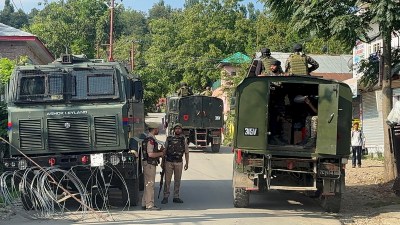Click here to join Express Pune WhatsApp channel and get a curated list of our stories
Postcards From The Past: How living in Kasba Peth turned a young boy into a historian
Pandurang Balkawade’s contributions include archaeological work with Deccan College to discover relics that date to 2,000 years ago.
 The past had wrapped around Balkawade from the start. Around 50 ft from his house to the west rose the majestic walls of Shaniwarwada, to the south lay Lal Mahal, on the east was Kasba Ganpati, who is the aradhya devat of Pune and, to the north, was the Mutha river. (Facebook/ PandurangBalkawade)
The past had wrapped around Balkawade from the start. Around 50 ft from his house to the west rose the majestic walls of Shaniwarwada, to the south lay Lal Mahal, on the east was Kasba Ganpati, who is the aradhya devat of Pune and, to the north, was the Mutha river. (Facebook/ PandurangBalkawade) “Even if you blindfold me, I can show you around Shaniwarwada. Every inch of the great fort is imprinted in my mind,” says historian Pandurang Balkawade. Born in Pune in 1960, he has spent a lifetime in a 150-year-old house in Kasba Peth that was built by his sardar ancestors during the era of the Peshwas. Balkawade has travelled abroad and has family members settled in various continents, but he never felt the need to leave Pune.
Instead, he has spent decades contributing to increasing our understanding of the city. This includes his archaeological work with Deccan College in discovering relics that date to 2,000 years ago. The artefacts, which include pots, were found in Kasba Peth.
“Kasba Peth was where Pune originally started. Even 60 years ago, we considered ourselves as belonging to the city. Areas like Sarasbagh were thought of as distant lands. The site where the Pune Municipal Corporation now stands was a part of Bhamboorda village that lay across the bridge. We used to say that we were city-dwellers while people who lived on the other side were village folks,” he says.
The past had wrapped around Balkawade from the start. Around 50 ft from his house to the west rose the majestic walls of Shaniwarwada, to the south lay Lal Mahal, on the east was Kasba Ganpati, who is the aradhya devat of Pune and, to the north, was the Mutha river. This was a slower time in Pune when a child could play for hours at the fort, imagining “where Peshwa Baji Rao would have sat, what games Chhatrapati Shivaji Maharaj would have played at Lal Mahal and how Jeeja Mata would have brought Shivaji Maharaj to Kasba Ganpati”.
Curiosity for history was encouraged by schools, which were unburdened by the pressures of cutting-edge competitions and soaring academic demands. “Teachers wanted to create better doctors, lawyers and engineers, so that the poorest of the poor could receive better healthcare, justice and infrastructure. Today, a lot of children are made to enter these professions because they are lucrative,” says Balkawade.
A pivotal moment came in his childhood, when he was a Class 5 student. Balkawade would avoid going to school and run off to play at the river banks. When it was time for school to end, he would pick up his bag and go home. One of the chapters that year was about Tanaji Malusare, the commander who sacrificed his life but won Kondana, or the Sinhagad fort, from the Mughals in 1670. It was a favourite story of many children in Pune and repeatedly told by elders. Reading the narrative fired up Balkawade as well. “That’s when my father said that we had an ancestor who had performed a similar feat,” he says.
This was Navji Balkawade, who had won back Kondana in 1693 after the fort was recaptured by the Mughals in 1689. “Navji Balkawade led a small group of men and defeated a much larger Mughal army. Chhatrapati Rajaram would hail the victory by saying the fort and the lion-like commander had both come back,” says Balkawade. That was the day Balkawade went back to school and told his teacher about his great ancestor.
Yet, Navji’s story was almost unknown in Balkawade’s school. “The headmaster told the teacher to ask me to go to every section and narrate the story. That day, I was a hero. That day, I felt that it is good to be a descendant of a hero but it came with the responsibility of living up to their bravery. If we did the right things, we could also become heroes. This is what history teaches us,” he says.
A shared past has tied together communities of Kasba Peth to this day. “As Pune grew, with people coming from different parts of the country to study or work, we have seen that in many areas, neighbours do not know each other. In Kasba Peth, families have been living for several generations. There are at least 10,000 people who know me in Kasba Peth and I know them,” he says.
It is a locality that remembers a time when there used to be four or five scooters in the area. “Only one in 25 houses had a cycle. You needed permits for cycles and paid tax. Every year, you had to go to the PMC to renew the cycle licence. They used to check if the cycle had a kerosene lantern. On roads, there was patrolling and whoever didn’t have a lantern in front of their cycles would be hauled up,” he says. When scooters came, priced at Rs 2,500, with Rs 500 as deposit, “there was a 10-year waiting period”. Balkawde has cycled all his life and got a scooter only in recent years.
One also needed permits for radios and a home could be raided and an unlicensed radio confiscated. In the world of Kasba Path, there were around 10 radios on which people followed the India-Pakistan war of 1971 as well as the Indian cricket team’s tour of England the same year.
“The team had a new player by the name of Sunil Gavaskar. The captain was Ajit Wadekar. The owner of a small restaurant that served tea had attached his radio to a loudspeaker and broadcast the commentary. Do you know how many people turned up to listen? Five thousand,” he says.
People came from Kasba Peth and villages around Pune. They would pack their dabbas and walk to enjoy the match. It was India’s first-ever series win against England, considered the most powerful cricketing nation. It is the kind of memory that brings people closer, Balkawde says.
Click here to join Express Pune WhatsApp channel and get a curated list of our stories













